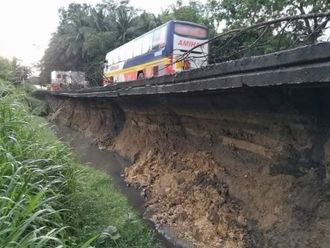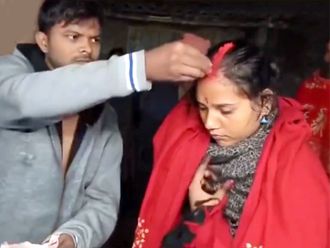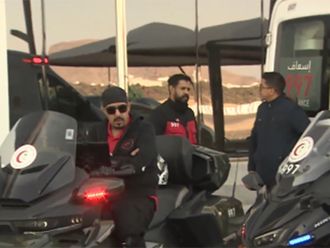
Manila: Road rage dominates as the primary cause of 72,000 road crashes in Metro Manila in 2022.
Official data has revealed a staggering total of 72,000 road crashes in Metro Manila. Surprisingly, the majority of these incidents were not attributed to human error or vehicle defects. Instead, they were primarily caused by road rage, as reported by the Metro Manila Development Authority (MMDA) and the Metro Manila Accident Recording and Analysis System.
The Philippines has no law against road rage, known in local parlance as “away kalsada”, where armed bullies often terrorise the weak.
72,000
Number of road crashes in Metro Manila in 2022, most were caused by road rage (Source: MMDA / MMARAS)Now, the Philippines’ Land Transportation Office (LTO) is pushing for specific legislation against road rage — further calling for a system to "profile" driver’s licence applicants, especially those who own firearms.
The agency is also proposing specific penalties against aggressive or violent behaviour on the road.
On Tuesday, LTO chief Vigor Mendoza II, said they are considering ways to make this happen in coordination with the Philippine National Police (PNP) Highway Patrol Group (HPG) and the country’s legislative chamber — in order to deal with a high number of road rage cases.
Plans are also afoot to review the agency’s "black points” or “demerit points” system, as road rage could now lead to the immediate revocation of driving licence.
While specific details were not revealed, the official said “driver profiling” would also be determined whether or not the licence applicants also own guns, the official added.
Proposed legislation against road rage
On September 4, the Philippines’s House of Representatives heard proposed penalties for road rage under House Bill No. 8991 (“An Act Penalising Acts of Road Rage and for Other Purposes,” or the “Anti-Road Rage Act”).
One provision being considered: If the incident of road rage has resulted in death, perpetrators face either imprisonment of six to 12 years, a fine of Php250,000 to Php500,000 ($8,786) — or both. The penalty is exclusive of damages incurred.
High-anger drivers are more likely to go 16 to 32 km/h (10 to 20 mph) over the speed limit, rapidly switch lanes, tailgate, and enter an intersection when the light turns red.
High-anger drivers get angry faster and behave more aggressively. They're more likely to swear or name-call, to yell at other drivers, and to honk in anger.
Spike in road rage incident
The LTO chief said that amid the spike in road rage incidents, they also plan to pull in relevant government agencies, in addition to the HPG.
“We are coordinating with HPG to merge our data so we can profile driver’s license applicants. We want to determine those who own guns so we can incorporate it into the license application,” he told Philippine media in Tagalog.
Firearms licensing
Mendoza also said he wanted to determine PNP’s requirements and basis for issuing permits to own and possess firearms as part of LTO’s plan to profile driver’s license applicants.
1.7 m
number of licensed firearms owners in the Philippines in 2014A 2014 study shows there were 1.7 million licensed firearms owners and 3.9 privately-owned guns (legally and illegally) in the Asian country.
Mendoza asserted that the penalties imposed on individuals involved in road rage incidents are deemed excessively lenient. He emphasised that the current penalty, which cannot exceed a four-year suspension or revocation of the driver's license, is “insufficient” to address cases where there is neither loss of life nor injury but the road rage behaviour is egregious.
“Those four years (in jail) would be if there’s death or injury; if there’s no death or injury, but there’s excessive road rage, there should be a special law — the penalty would not be just a simple violation of (Republic Act) 4136 (on) reckless driving. It must be a specific penalty; we file it and penalise road rage [suspects],” he said.
3.9 m
estimated number of 3.9 privately-owned guns (legally and illegally) in the Philippines.DUI rules and points system
Under existing rules, driving a motor vehicle under the influence of alcohol, dangerous drugs and/or substance upon final conviction by a regular court of competent jurisdiction (Section 12, R.A. 10586), results in a penalty of Php20,000 (about $390) + confiscation & suspension of license for 1 year.
For reckless driving, the penalty is Php2,000 ($35) for first offence; PhpP3,000 (53) for second offence + suspension of licence for three months; and six months for third offence. Subsequent offences result in a Php10,000 ($178) penalty and revocation of licence for 2 years.
For other violations like illegal parking, disobeying traffic lights (jumping the red light), driving in prohibited roads/areas, failure to darken headlamps, and illegal overtaking or turning, the fine is Php1,000.
How many demerit points in LTO?
Each violation (see below) will have a corresponding point equivalent, and every violation point will be deducted from the starting 20.
In the LTO “Point System”, once the 20 points have been spent or deducted, the penalty is a revocation of the Driver's License, plus a suspension from driving for a period of two (2) years.
How to check license violations online?
Visit the LTO LTMS portal and create an account. Once logged in, click on the “Violations” icon. Your demerit points will then be displayed along with the corresponding violation.
Philippine traffic violations and their corresponding black "demerit" points.
Light Violations (1 black/demerit point)
Examples:
Driving a motorcycle with a child a board on public roads ((first offence))
Using smart phones or any electronic device while driving ((first offence))
Failure to your seatbelt, including out of the passenger ((first offence))
Failure to wear a motorcycle helmet, both for the driver rider in the back (first offence)
Smoke belching (first offence)
Reckless driving (first offence)
Driving in place is not intended for traffic or parking in areas not designated for parking
Not getting a drivers license or the ORCR of the motor vehicle while driving
Failure to provide a cover to cargo or freight trucks
Overtaking on men working or caution signs
Not yielding right away to vehicles on the highway when entering from a private road
Not using signals lights when turning
Not following the proper lane designation when taking a turn
Unsafe towing
Overcharging or undercharging of fare
No franchise or Certificate of Public Conveyance carried inside the PUV
Defective, fast, or tampered with taxi metre
Operating without a taxi seal or with an old metre or broken seal
Broken, tampered, joined, reconnected, fake or altered sealing wire of taxi meters
Not providing fare discounts to those entitled to them
No signboard for PUVs
Pick-up and drop off of passengers outside the terminal for buses
Failure to display fare matrix (for public transport)
Not displaying International System of Access inside a PUV
Not designating seats for the use of persons with disabilities (PWDs)
Refusing to transport PWDs
Franchise break of the conditions stated on the 2-11 revised terms and conditions on the certificate of public conveyance
Not displaying a “no smoking” sign and allowing personnel or passengers to smoke inside PUV
Less Grave Violations — 3 black/demerit points
Examples:
- Driving a motorcycle with a child aboard on public roads (second offence)
- Using smart phones or any electronic device while driving (second offence)
- Failure to wear a seatbelt for both the driver and passenger (second offence)
- Failure to wear a motorcycle helmet for both driver and back rider (second offence) Smoke belching (second offence) Reckless driving (second offence)
- Failure to wear a motorcycle helmet for both driver and back rider (second offence) Smoke belching (second offence) Reckless driving (second offence)
- Intentional traffic abstruction
- Illegal parking
- Allowing passengers on the motor vehicle roof
- Not dimming headlights when approaching another motor vehicle
- Hitching or permitting a bicycle, a person, a skateboard, a motorcycle, or tricycle to hitch for a motor vehicle
- Not yielding right of way to pedestrian to the pedestrian crossing
- Not shutting down the engine and engaging the hand break when the vehicle is unattended.
- Failure to attach licence plates
- Tampering with licence plates
- Load-extensive beyond the projected width without a permit
- Operating a bus or truck with cargo exceeding 160kg of its load limit
- Trip-cutting for PUVs (public utility vehicles)
- Violations in connection with motor vehicle registration
Grave violations — 5 black/demerit points
Examples:
- • Driving a motorcycle with a child on board on public roads (third and succeeding offences)
- • Using smart phones electronic device while driving (third and succeeding offences)
- Failure to wear a seatbelt, for both driver and passenger (third and succeeding offences)
- Failure to wear a motorcycle helmet for both driver in the back rider (third and succeeding offences)
- Smoke belching (third offence and succeeding offences)
- Reckless driving (third and succeeding offence)
- Driving a motor vehicle used for committing a crime
- Committing a crime while driving a vehicle
- Driving a PUV and collecting fares without the franchise
- Driving under the influence (DUI) of alcohol, dangerous drugs or other similar substance
- Axle overloading
- Driving an unregistered motor vehicle
- Driving without a valid drivers licence
- Overtaking (at a curve, when left side is not clear, at an intersection, in a no-overtaking zone; within an unsafe distance; upon a crest or grade; at a railway crossing)
- Not giving way to an overtaking vehicle
- Speeding when being overtaken
- Cutting an overtaking vehicle
- Failure to yield right of way
- Driving a motorcycle with than more passenger
- Presentation of fake CPC, OR/CR, plates, stickers, or tags
- Operating a vehicle with defective, improper, or illegal accessories, devices, equipment or parts
- Carrying illegal or prohibited cargo (drugs, illegal firearms, endangered animals, etc)
- Unauthorised motor vehicle modification
- Operating a right-hand-drive motor vehicle
- Driving against the traffic flow
- Fraud concerning the registration or renewal of registration of the motor vehicle
Source: https://ltoportal.ph/check-lto-violations-penalties-fines/











